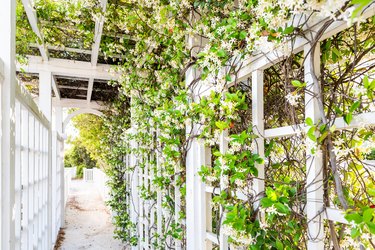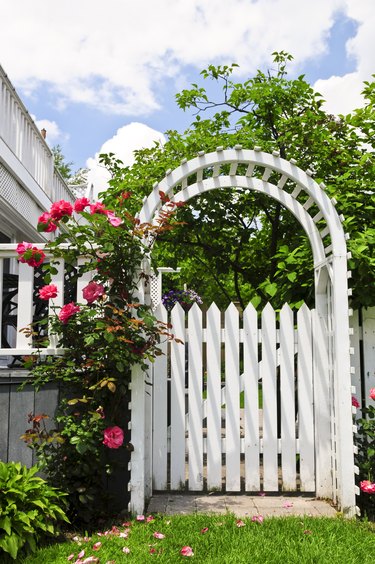
When landscaping your property, it's always a good idea to add some vertical definition to create a more interesting and inviting outdoor space, and nothing does this better than a garden trellis or a garden arbor. Note that they aren't the same thing: A trellis is basically a grid that may or may not be self-supporting, while an arbor is a freestanding structure with a roof, although the roof covering is usually foliage. Both can support climbing plants, but an arbor can also provide a sheltered sitting area or can frame an entryway to an outdoor room, whereas a trellis is often used as a screen. In their own ways, they provide definition by separating the landscape into sections or demarcating borders.
Unlike a pergola, which is a fairly robust structure with a solid roof that is often attached to the main house, a garden arbor is a comparatively simple affair. Arbors and trellises are outdoor structures that provide support for vertical growth in the garden, which especially benefits narrow, flat spaces and landscapes with few trees. A trellis can be attached to a fence or the house siding to integrate that part of the outdoor space into the overall landscape design, and an arbor adds an architectural element, much like an archway in a medieval courtyard.
Video of the Day
Video of the Day
Homeowners plant vining vegetables, flowers and other greenery for a number of reasons, and left to their own devices, vines will attach themselves to siding, fencing, trees and even other vines, so a trellis or arbor serves the practical purpose of protecting vulnerable structures and plants from creeping tendrils. You have control of the placement and the power to direct growth, and there are many ways to take advantage of this power in the design of your outdoor living space.
A Trellis for Every Purpose
Because the main function of a trellis is to provide a foothold for vines and climbing plants, a lattice structure works best, but the lattice can take several shapes and be made of many different materials. A trellis can be as simple as a ladder made of twigs joined with pieces of jute or a complex arch-shaped affair constructed from wrought iron. The most common material for a trellis is wood, but metal and vinyl are also common, and it's easy to find a trellis at any home and garden center to attach to a fence or the side of the house and grow lilacs, roses or ivy.
Not all trellises are flat, and while most require support, some are designed to be placed in the middle of the garden. A teepee trellis or obelisk trellis, for example, is a basic requirement for growing pole beans, tomatoes or other climbing vines. Some freestanding trellises are fairly small and become quickly overgrown. Others are larger and are designed to complement the greenery, and some come with their own planter boxes, allowing you to move the climbing vines at will. Are you growing cucumbers, squashes, melons or other large vegetables? An A-frame trellis is an inexpensive way to keep them off the ground.
A Garden Arbor Is Alive
Unlike a trellis, which you can easily take down and move to suit the changing landscape, an arbor is there to stay, so it's important to determine its purpose before you erect it. You may want to use it as a sitting area or a gathering place for a large group, or you may simply want it to be a focal point to define the garden entrance. You can use an arbor to provide a passage from one part of the garden to another, effectively creating outdoor rooms within the overall landscape.
An arbor is a hardscape element in its own right and can do its job with or without greenery, but it isn't a pergola, and it comes to life when it's supporting plants. It should be made of a material that can withstand the moisture under a dense layer of foliage. Wood arbors constructed with redwood or cedar are common and easy to find at most garden centers, but vinyl is increasing in popularity because it's a lightweight, long-lasting and DIY-friendly material.
Wrought iron and other metals are also good options for garden structures given the durability of metal and ease with which it can be worked into a garden design. Arbors don't have to be showy because they are hidden under the plants growing on them, so you can make one out of very simple materials, even rebar.

Landscaping Ideas for a Little Magic
Because it's a vertical structure, a trellis or garden arbor covered with foliage is one of the most visible landscaping elements you can add. It's common to place an arbor at the entrance of the garden, flanked on both sides by hedges or shrubs and providing an enclosure for the walkway and gate. Because an arbor is alive, it offers an invitation to explore it closely as well as what lies beyond it. With its covering of ivy, jasmine, honeysuckle or climbing roses, it's a garden element that can be shaped and nurtured to suit the surroundings.
Inside the garden, you can use an arbor to create an outdoor room. For example, you may have an expanse of lawn in the front yard, but to one side of the house, a well-placed arbor invites the visitor to a more secluded area where seating is provided for relaxing, and the lawn transitions into a garden bed, terraced hillside or perhaps a water feature. Because it's an arch, a garden arbor acts as a doorway, and it can lead to your front door or to another world altogether.
A trellis is a more simple structure whose main purpose may be to display your favorite roses, but you can also use one to camouflage an unsightly area or to gain privacy. If you have an unattractive chain-link fence or a wooden fence in less than perfect condition, a well-placed trellis on which you grow grapes or roses may be the perfect cure, with its foliage growing above and beyond the fence line and rendering the fence itself moot. A trellis can work the same magic on your porch, in front of the garage or on the side of the house.
Blending Structure and Materials
Because it's one of the most visible elements in the landscape, a trellis or garden arbor sets the tone, and you want it to harmonize with the overall theme you're trying to set. A large redwood arbor will probably look out of place in a small English garden with a picket fence, where a smaller wood, vinyl or metal structure with complex latticework and a white finish would better fit in. Conversely, a dainty white trellis or arbor might not be the best choice for an expansive rock garden, where strength and solidity rule.
Choose materials that can handle the weight of the fruits and flowers they have to support. You may, for instance, erect a trellis to support squashes, which can get very heavy, so you want a metal one that can handle the weight, not a flimsy wooden one assembled with staples. It helps to do a little research about the plants you intend to grow because you might find that they are heavier and more vigorous than you expect. For example, if you live in USDA zone 6 or above and you want to grow passionflowers as perennials, make your trellis strong because passionflower vines grow quickly and can reach out as far as 30 feet. Even jasmine and wisteria can quickly topple a makeshift structure.
Perhaps even more than other outdoor structures, trellises and arbors are subject to rot and decay because they are perpetually covered with foliage and don't get good air circulation or sunlight. If you like to DIY your own garden structures from scratch, keep this in mind when choosing materials. Other than redwood, cedar, teak and some exotic species, wood generally doesn't hold up unless it's painted, pressure treated or coated with vinyl. Metals must be corrosion-resistant or coated with a rust-preventative finish, and any wood in contact with the ground must always be pressure treated.

Construction Tips and Design Ideas
A garden arbor is basically a structure with four posts connected by beams or rafters and filled in with lattice, balusters, rails or some type of supports for vines. It's a fairly straightforward DIY project to build one with straight rafters for a shaded sitting area or a windbreak, but what if you want to make a decorative one that has curved rafters that form an archway? You can't buy curved wood (unless it's warped), so you need to make it. Follow this simple technique to cut perfectly curved arches out of plywood:
- Cut a sheet of plywood to the length you desire for the rafters using a circular saw and then cut two 2- to 3-inch strips from the offcut. Screw those strips to the top and bottom edge of the first sheet to form dams.
- Wedge a piece of wood bender board between the dams, forcing it to bend and form a curve. Trace the curve with a pencil. If you want a sharper curve, use a longer piece of bender board.
- Move the ends of the bender board a distance along the dams equal to the width you want the rafter to be and trace another line. Remove the dams and cut along the lines with a jigsaw.
- Use that board as a template to mark the shape onto the lumber or plywood you'll use for the rafter and then cut out the rafter. If you use plywood, you can cut multiple pieces and glue them together to make a thicker rafter. Glue them together with construction adhesive and clamp them overnight.
Constructing a trellis or arbor from a combination of materials may make the job easier and the final product more interesting. Instead of making a wood lattice for your arbor, which can be painstaking work, simply drill holes in the posts and stretch steel cable tightly between them. This is also a good way to make a lightweight and durable trellis. You can also use copper pipe; its color coordinates well with wood when it's new, and as it ages, the color only improves, taking on the greenish hues of the rest of the garden.
A trellis doesn't need to have a particular shape or even a frame as long as it can support whatever is growing on it. Some innovative homeowners have made trellises with old curtain rods or plumbing pipes, wagon wheels, bamboo and even by stringing together old garden tools. Garden design is a creative endeavor. Creativity is fun, and you can have plenty of that designing and building trellises and arbors and growing vines to fill your outdoor space with color and free food.